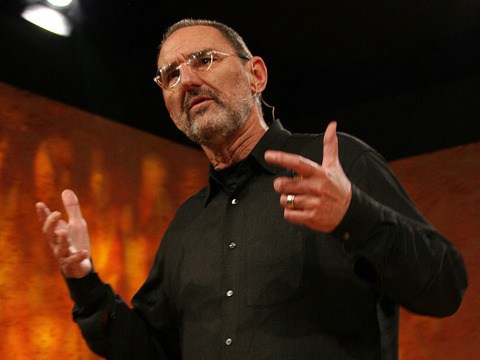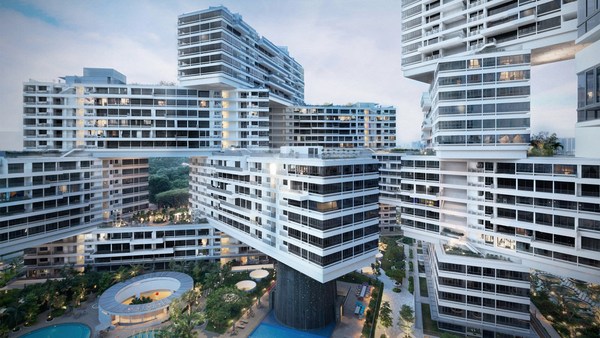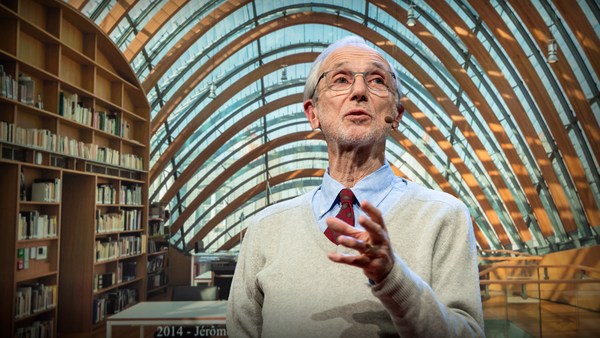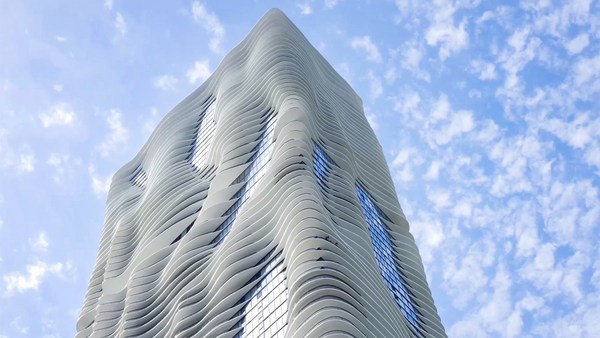Today I'm going to speak to you about the last 30 years of architectural history. That's a lot to pack into 18 minutes.
It's a complex topic, so we're just going to dive right in at a complex place: New Jersey. Because 30 years ago, I'm from Jersey, and I was six, and I lived there in my parents' house in a town called Livingston, and this was my childhood bedroom. Around the corner from my bedroom was the bathroom that I used to share with my sister. And in between my bedroom and the bathroom was a balcony that overlooked the family room. And that's where everyone would hang out and watch TV, so that every time that I walked from my bedroom to the bathroom, everyone would see me, and every time I took a shower and would come back in a towel, everyone would see me. And I looked like this. I was awkward, insecure, and I hated it. I hated that walk, I hated that balcony, I hated that room, and I hated that house.
And that's architecture. (Laughter) Done. That feeling, those emotions that I felt, that's the power of architecture, because architecture is not about math and it's not about zoning, it's about those visceral, emotional connections that we feel to the places that we occupy. And it's no surprise that we feel that way, because according to the EPA, Americans spend 90 percent of their time indoors. That's 90 percent of our time surrounded by architecture. That's huge. That means that architecture is shaping us in ways that we didn't even realize.
That makes us a little bit gullible and very, very predictable. It means that when I show you a building like this, I know what you think: You think "power" and "stability" and "democracy." And I know you think that because it's based on a building that was build 2,500 years ago by the Greeks. This is a trick. This is a trigger that architects use to get you to create an emotional connection to the forms that we build our buildings out of. It's a predictable emotional connection, and we've been using this trick for a long, long time. We used it [200] years ago to build banks. We used it in the 19th century to build art museums. And in the 20th century in America, we used it to build houses. And look at these solid, stable little soldiers facing the ocean and keeping away the elements.
This is really, really useful, because building things is terrifying. It's expensive, it takes a long time, and it's very complicated. And the people that build things -- developers and governments -- they're naturally afraid of innovation, and they'd rather just use those forms that they know you'll respond to.
That's how we end up with buildings like this. This is a nice building. This is the Livingston Public Library that was completed in 2004 in my hometown, and, you know, it's got a dome and it's got this round thing and columns, red brick, and you can kind of guess what Livingston is trying to say with this building: children, property values and history. But it doesn't have much to do with what a library actually does today. That same year, in 2004, on the other side of the country, another library was completed, and it looks like this. It's in Seattle. This library is about how we consume media in a digital age. It's about a new kind of public amenity for the city, a place to gather and read and share.
So how is it possible that in the same year, in the same country, two buildings, both called libraries, look so completely different? And the answer is that architecture works on the principle of a pendulum. On the one side is innovation, and architects are constantly pushing, pushing for new technologies, new typologies, new solutions for the way that we live today. And we push and we push and we push until we completely alienate all of you. We wear all black, we get very depressed, you think we're adorable, we're dead inside because we've got no choice. We have to go to the other side and reengage those symbols that we know you love. So we do that, and you're happy, we feel like sellouts, so we start experimenting again and we push the pendulum back and back and forth and back and forth we've gone for the last 300 years, and certainly for the last 30 years.
Okay, 30 years ago we were coming out of the '70s. Architects had been busy experimenting with something called brutalism. It's about concrete. (Laughter) You can guess this. Small windows, dehumanizing scale. This is really tough stuff. So as we get closer to the '80s, we start to reengage those symbols. We push the pendulum back into the other direction. We take these forms that we know you love and we update them. We add neon and we add pastels and we use new materials. And you love it. And we can't give you enough of it. We take Chippendale armoires and we turned those into skyscrapers, and skyscrapers can be medieval castles made out of glass. Forms got big, forms got bold and colorful. Dwarves became columns. (Laughter) Swans grew to the size of buildings. It was crazy. But it's the '80s, it's cool. (Laughter) We're all hanging out in malls and we're all moving to the suburbs, and out there, out in the suburbs, we can create our own architectural fantasies. And those fantasies, they can be Mediterranean or French or Italian. (Laughter) Possibly with endless breadsticks.
This is the thing about postmodernism. This is the thing about symbols. They're easy, they're cheap, because instead of making places, we're making memories of places. Because I know, and I know all of you know, this isn't Tuscany. This is Ohio. (Laughter)
So architects get frustrated, and we start pushing the pendulum back into the other direction. In the late '80s and early '90s, we start experimenting with something called deconstructivism. We throw out historical symbols, we rely on new, computer-aided design techniques, and we come up with new compositions, forms crashing into forms. This is academic and heady stuff, it's super unpopular, we totally alienate you. Ordinarily, the pendulum would just swing back into the other direction. And then, something amazing happened.
In 1997, this building opened. This is the Guggenheim Bilbao, by Frank Gehry. And this building fundamentally changes the world's relationship to architecture. Paul Goldberger said that Bilbao was one of those rare moments when critics, academics, and the general public were completely united around a building. The New York Times called this building a miracle. Tourism in Bilbao increased 2,500 percent after this building was completed. So all of a sudden, everybody wants one of these buildings: L.A., Seattle, Chicago, New York, Cleveland, Springfield. (Laughter) Everybody wants one, and Gehry is everywhere. He is our very first starchitect.
Now, how is it possible that these forms -- they're wild and radical -- how is it possible that they become so ubiquitous throughout the world? And it happened because media so successfully galvanized around them that they quickly taught us that these forms mean culture and tourism. We created an emotional reaction to these forms. So did every mayor in the world. So every mayor knew that if they had these forms, they had culture and tourism.
This phenomenon at the turn of the new millennium happened to a few other starchitects. It happened to Zaha and it happened to Libeskind, and what happened to these elite few architects at the turn of the new millennium could actually start to happen to the entire field of architecture, as digital media starts to increase the speed with which we consume information. Because think about how you consume architecture. A thousand years ago, you would have had to have walked to the village next door to see a building. Transportation speeds up: You can take a boat, you can take a plane, you can be a tourist. Technology speeds up: You can see it in a newspaper, on TV, until finally, we are all architectural photographers, and the building has become disembodied from the site. Architecture is everywhere now, and that means that the speed of communication has finally caught up to the speed of architecture.
Because architecture actually moves quite quickly. It doesn't take long to think about a building. It takes a long time to build a building, three or four years, and in the interim, an architect will design two or eight or a hundred other buildings before they know if that building that they designed four years ago was a success or not. That's because there's never been a good feedback loop in architecture. That's how we end up with buildings like this. Brutalism wasn't a two-year movement, it was a 20-year movement. For 20 years, we were producing buildings like this because we had no idea how much you hated it. It's never going to happen again, I think, because we are living on the verge of the greatest revolution in architecture since the invention of concrete, of steel, or of the elevator, and it's a media revolution.
So my theory is that when you apply media to this pendulum, it starts swinging faster and faster, until it's at both extremes nearly simultaneously, and that effectively blurs the difference between innovation and symbol, between us, the architects, and you, the public. Now we can make nearly instantaneous, emotionally charged symbols out of something that's brand new.
Let me show you how this plays out in a project that my firm recently completed. We were hired to replace this building, which burned down. This is the center of a town called the Pines in Fire Island in New York State. It's a vacation community. We proposed a building that was audacious, that was different than any of the forms that the community was used to, and we were scared and our client was scared and the community was scared, so we created a series of photorealistic renderings that we put onto Facebook and we put onto Instagram, and we let people start to do what they do: share it, comment, like it, hate it. But that meant that two years before the building was complete, it was already a part of the community, so that when the renderings looked exactly like the finished product, there were no surprises. This building was already a part of this community, and then that first summer, when people started arriving and sharing the building on social media, the building ceased to be just an edifice and it became media, because these, these are not just pictures of a building, they're your pictures of a building. And as you use them to tell your story, they become part of your personal narrative, and what you're doing is you're short-circuiting all of our collective memory, and you're making these charged symbols for us to understand. That means we don't need the Greeks anymore to tell us what to think about architecture. We can tell each other what we think about architecture, because digital media hasn't just changed the relationship between all of us, it's changed the relationship between us and buildings. Think for a second about those librarians back in Livingston. If that building was going to be built today, the first thing they would do is go online and search "new libraries." They would be bombarded by examples of experimentation, of innovation, of pushing at the envelope of what a library can be. That's ammunition. That's ammunition that they can take with them to the mayor of Livingston, to the people of Livingston, and say, there's no one answer to what a library is today. Let's be a part of this. This abundance of experimentation gives them the freedom to run their own experiment.
Everything is different now. Architects are no longer these mysterious creatures that use big words and complicated drawings, and you aren't the hapless public, the consumer that won't accept anything that they haven't seen anymore. Architects can hear you, and you're not intimidated by architecture. That means that that pendulum swinging back and forth from style to style, from movement to movement, is irrelevant. We can actually move forward and find relevant solutions to the problems that our society faces. This is the end of architectural history, and it means that the buildings of tomorrow are going to look a lot different than the buildings of today. It means that a public space in the ancient city of Seville can be unique and tailored to the way that a modern city works. It means that a stadium in Brooklyn can be a stadium in Brooklyn, not some red-brick historical pastiche of what we think a stadium ought to be. It means that robots are going to build our buildings, because we're finally ready for the forms that they're going to produce. And it means that buildings will twist to the whims of nature instead of the other way around. It means that a parking garage in Miami Beach, Florida, can also be a place for sports and for yoga and you can even get married there late at night. (Laughter) It means that three architects can dream about swimming in the East River of New York, and then raise nearly half a million dollars from a community that gathered around their cause, no one client anymore. It means that no building is too small for innovation, like this little reindeer pavilion that's as muscly and sinewy as the animals it's designed to observe. And it means that a building doesn't have to be beautiful to be lovable, like this ugly little building in Spain, where the architects dug a hole, packed it with hay, and then poured concrete around it, and when the concrete dried, they invited someone to come and clean that hay out so that all that's left when it's done is this hideous little room that's filled with the imprints and scratches of how that place was made, and that becomes the most sublime place to watch a Spanish sunset.
Because it doesn't matter if a cow builds our buildings or a robot builds our buildings. It doesn't matter how we build, it matters what we build. Architects already know how to make buildings that are greener and smarter and friendlier. We've just been waiting for all of you to want them. And finally, we're not on opposite sides anymore. Find an architect, hire an architect, work with us to design better buildings, better cities, and a better world, because the stakes are high. Buildings don't just reflect our society, they shape our society down to the smallest spaces: the local libraries, the homes where we raise our children, and the walk that they take from the bedroom to the bathroom.
Thank you.
(Applause)





